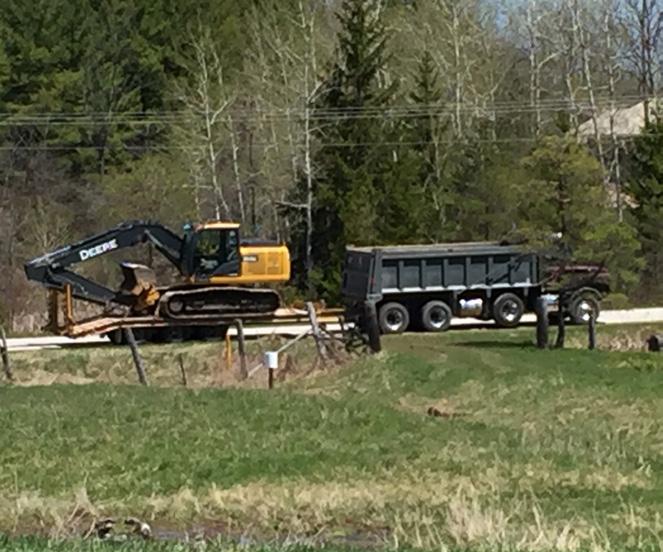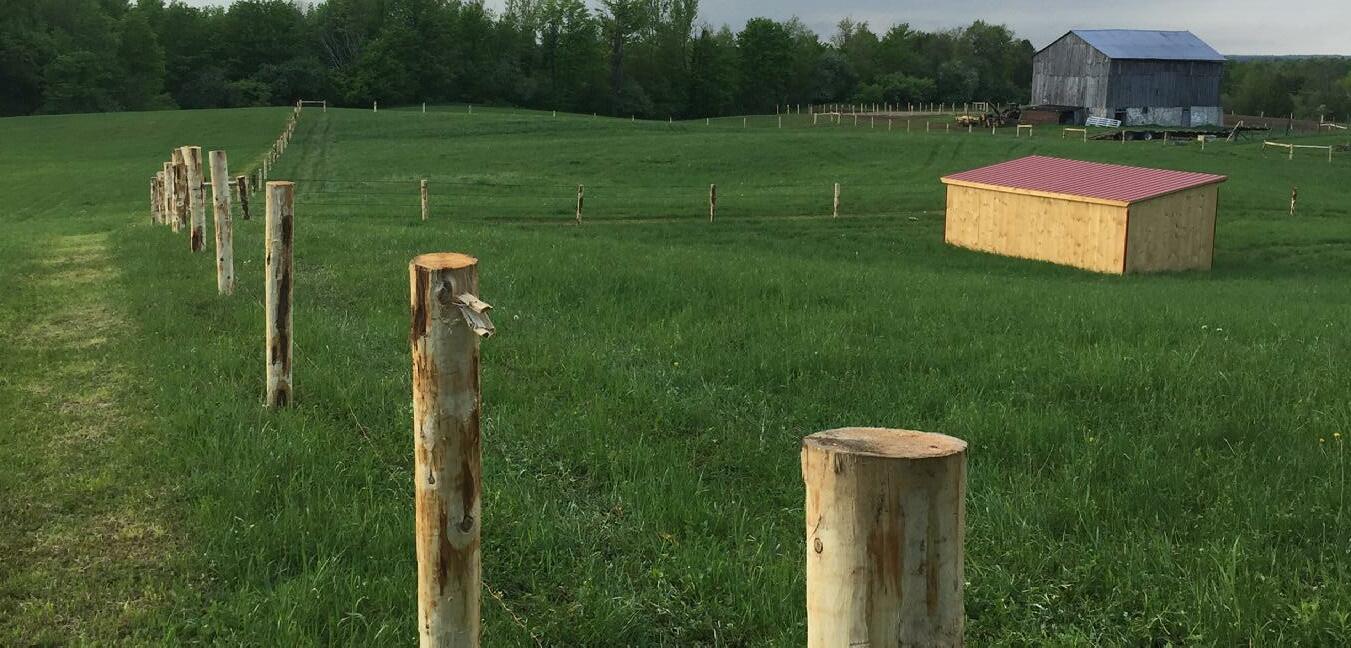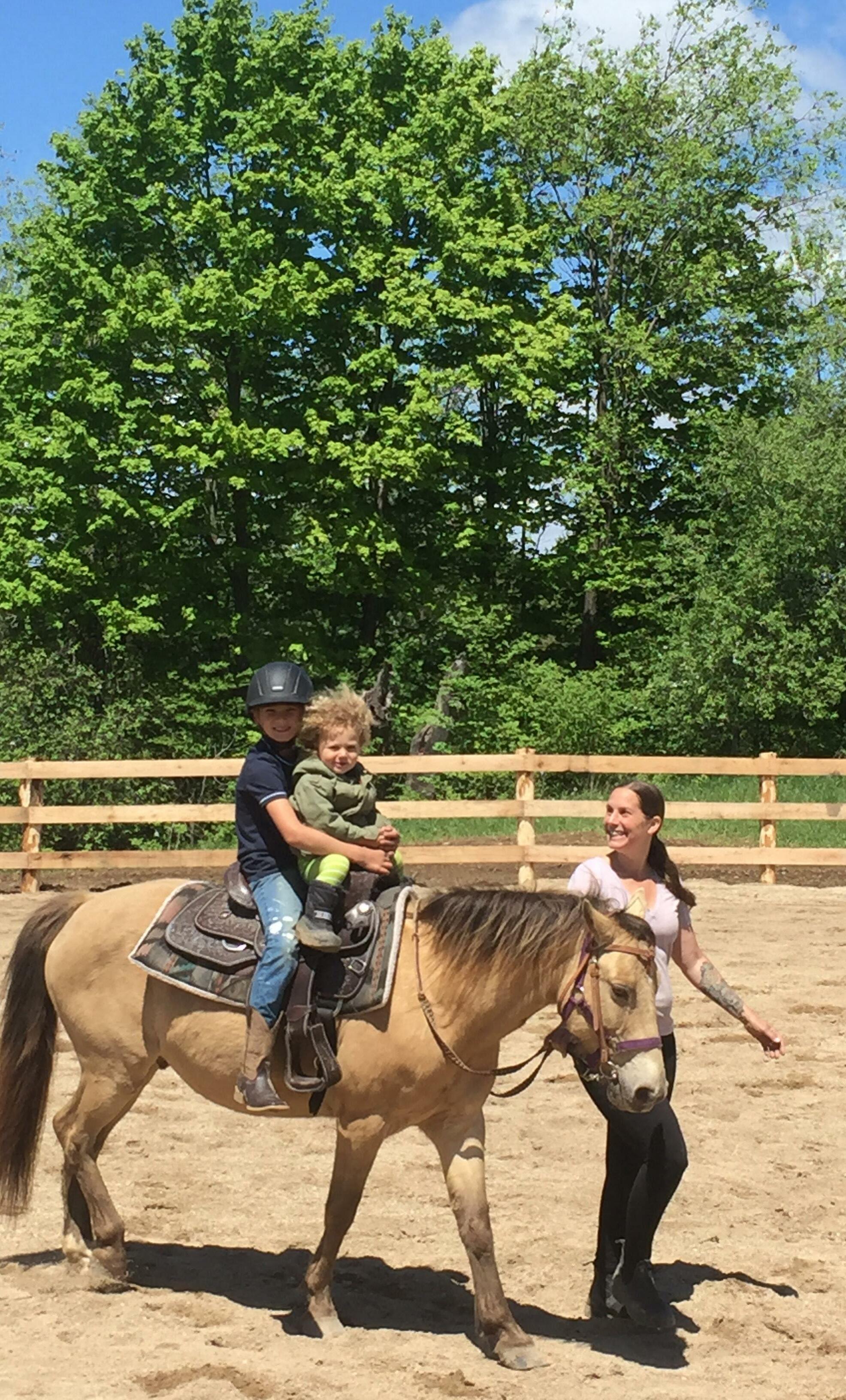
9 minute read
COVER STORY
Mama Country and I both grew up in Scarborough. We actually went to the same high school. She likes to say that I’m “significantly older” than her; so we never dated until later in life.
After we were married, we made some life goals for ourselves. It was a dream of ours to one day live in the country and own horses. So when we decided to pull the chute on city life and buy a farm in Grey County, we went full speed ahead on our dream to own an equestrian property.
Advertisement
But how does one transform an organic hobby farm into an organic hobby farm with horses?
The first step was to ask around for help, but we didn’t know anybody. We had no friends yet. Well, just one; Reuben McCallum.
Reuben represented us during our home purchase and became a trusted resource and friend once the deal was done. He helped to guide us when we’d ask questions we never thought we’d ask, like:
“How do you build a riding ring?” Or, “Who can build paddock fencing with electric wires?” Or, “Where can we find a run-in for our horses?”
Thanks to Reuben and his ability to connect us with the right folks, our dreams of horse ownership and farm life were starting to become a reality.
Truth be told, we had already purchased a few horses and were boarding them at a facility in West Grey. I was learning to ride for the first time, while Mama Country was getting back into the swing of things after a 10-year hiatus. The cost of boarding was reasonable, but we had the space on our 13-acre property so my inner Sicilian kept whispering (screaming and hand gesturing), “We have to bring our horses here as soon as possible!”
The Plan: Build 3 paddocks (one with a run-in) and a riding ring. The work begins.

The riding ring coming to life.
The Timeline: Finish the paddocks and ring by the end of May 2020 (we moved here in November 2019).
Our first call was to Al Thompson. He and his son, Ian, own Al Thompson Excavating (I’m not sure where they got the name) and were recommended to us by Reuben. Al came by our property to check out our plan, get the lay of the land (literally), and prepare a quote for us. We felt his quote was fair and went ahead and hired them to build our riding arena. Mama Country was getting excited!
I’ll never forget the sight of a dump truck hauling an excavator rolling up to our barn laneway. It was something I’d never seen before. Odd for an Italian guy, you’re thinking. Next, the bulldozer was dropped off. We now lived on a construction site. You should have seen the looks on our boys’ faces. Both of whom love playing with toy construction vehicles. Now they had the real thing right in front of them.
And away they went.
The bulldozer moved the earth to level out the land for the riding ring, the excavator loaded it into the dump truck which hauled it away. Load after load. The ring was coming to life. Then came the sand.
Our riding ring is a fair size. Which is great when you’re in there riding around on a horse, but costly when you factor in the number of truckloads of sand that had to be hauled in. Load after load. The riding ring was complete. Almost.
Al and Ian stuck around a bit longer even after the bulldozer, excavator and dump trucks were gone. We had decided to remove the grass from one of the paddocks (now known as the Pony Paddock), because Cedar (our Pony) could founder if he ate too much grass. What? Founder? That’s what I said. Apparently, ponies can become lamanitic (the not-so-scientific version of diabetes for horses) from the sugars in the grass. Who’d have thought? A horse that couldn’t eat grass.
It’s worth noting that Al and Ian Thompson completed the job on time and 100% on budget - not a penny more than their original quote. We didn’t know it at the time, but the ring was designed and built in such a way so as to drain water from rain and snow out of the ring - no puddling for the horses to navigate. It still functions beautifully.
But what is a riding ring without fences? And what is an equestrian property without paddocks? And what is a paddock without a run-in?
We relied on our new neighbours, Jeff Russell and Anna McCarthy, for advice on who could build paddock fencing. They mentioned a fellow by the name of Paul Frey. Paul had built some fencing for one of their family members and came highly recommended.
Now, I had never spoken to a Mennonite
Paddocks are almost finished

Paul Frey lines up a fence post.

before this point, so you can imagine my delight when I reached Paul by phone. He was jolly and direct. Not a lot of small talk. His accent sounded like a mix of Irish and Jamaican. A pleasant fellow, indeed. He came by the farm, walked the property with me and measured out the distance of the paddock fencing that Mama Country and I had sketched out on paper before marking the corners and fence lines with sticks we found lying around in an old wood pile.
We decided to hire Paul to build our paddocks, but time was ticking. We had to get everything built before the end of May. The weather proved to be problematic at times delaying his start, but Paul’s crew finally hit the ground running (literally, his guys actually ran from A to B to get the job done). I’ve never seen people work harder. I was amazed at their efficiency...and their accents.
When all was said and done, Paul Frey’s crew had all 3 paddocks built and our riding ring fenced off, plus all the requisite gates, and a hitching post installed before our deadline. We did a bit of research to find a good price on a run-in. We ended up going with a 10ft x 20ft because we envisioned acquiring more horses in the future.
“Horses are like potato chips,” we were told. “You can’t own just one.”
We ordered our run-in from Henry Brubacher of Brubacher’s Harness Supplies in Wallenstein. A jovial fellow who turns out to be quite handy at mending and customizing saddles. It arrived on a flatbed in advance of our fencing and became the central figure of our back 40 prior to the paddocks being built. We had a minor issue with it, but Henry was quick to remedy it with the help of our neighbour up the road, Daniel Bauman who arrived in a horsedrawn buggy to save the day. We could officially move our horses home!
“And the rest was easy,” said no horse owner ever.
Mama Country and the Boys enjoy a pony ride on Cedar.

Filming of Wolf Dog in Markdale 1958

The year 1958 was a great year for film releases: Orson Welles’ low-budget masterpiece “Touch of Evil”, Hitchcock’s “Vertigo”, and Richard Brook’s “Cat on a Hot Tin Roof” were in the mix. If you preferred to catch your flicks at the local drive-in, you would have seen such sci-fi classics as “The Fly” or “The Blob”. It was also the year that “Wolf Dog”, a movie filmed in the Markdale area, was released.
The movie tells the story of a parolee (Jim Davis) and his wife and son (Allison Hayes, Tony Brown) who buy a cattle ranch so that he might begin a new life. His efforts to do so are thwarted by an unscrupulous neighbouring rancher, played by Canadian character actor Austin Willis, who wants the land for himself.
I first heard about the film from my friend John Butler, who introduced me to Jeff Wilson, a cartoonist and film historian, who single-handedly kept the film alive for the present generation to see. In the late fifties Normandie Productions, a branch of an American television production company was operating in Canada, shooting series such as “Hawkeye and the Last of the Mohicans”, “Cannonball”, and “Tugboat Annie” in Mimico and Pickering. I can recall all these shows running as reruns during rainy afternoons at my summer cottage when I was a child. The owner, Arthur Gottlieb, green-lit a low-budget film project to be shot in the summer of 1957 in a rural community north of Toronto.
The director would be Sam Newfield, widely considered to be the most prolific director working in the industry. His immense output would be the envy of any professional, since it was believed he had made over 300 films since the beginning of his career in the silent era. His output was so extensive that he had to direct under three different names. Unfortunately, quantity does not necessarily mean quality, and Sam shot the films quickly, often in less than a week, largely because of the paltry amount he was paid. Another veteran, Russian-born Louis Stevens wrote the script. He had recently penned three of the “Hawkeye” episodes, so immediacy must have offered Gottlieb an affordable solution. Markdale was abuzz that summer of 1957. Ron Wyvell was there for much of the shooting, having discovered it by accident after coming into town on his bike and deciding to stick around for the fun. He even, along with other locals, had the opportunity to work as an extra in the film. Stars Jim Davis (later of “Dallas” fame”) and Allison Hayes (best known for the cult classic “The Attack of the 50-Foot Woman”) gave the community a Hollywood feel, and the experience was memorable for all the residents who were a part of it.
The year after “Wolf Dog” came out, it had a brief run in Owen Sound and subsequently, forgotten everywhere. Jeff Wilson was not even born when “Wolf Dog” was made, but his mother was one of the extras, and the story of its production was a source of interest for him his entire life. Even though the only complete copy known to exist is in the Library of Congress (there are partial copies in the National Archives of Canada), he has put together a complete film by inserting lower quality generations of the missing reels so the viewer can get a sense of what the original looked like. A copy of this film is available through the Grey Highlands Public Library in Markdale. He has even set up a Facebook page, “Wolf Dog”, 1958 (The Movie Made in Markdale) and has also made the film available for screening on Youtube.
With the movie safely rescued from obscurity, one wonders about the prospect of another feature being nproduced in Grey Highlands. With the abundance of talent in our area, it should not be a stretch to imagine such an occurrence. “Wolf Dog II”, anyone?
SPEAKING VOLUMES BOOKS & AUDIO 12 Toronto Road, Flesherton kevinarthurland@gmail.com kevinarthurland.ca




